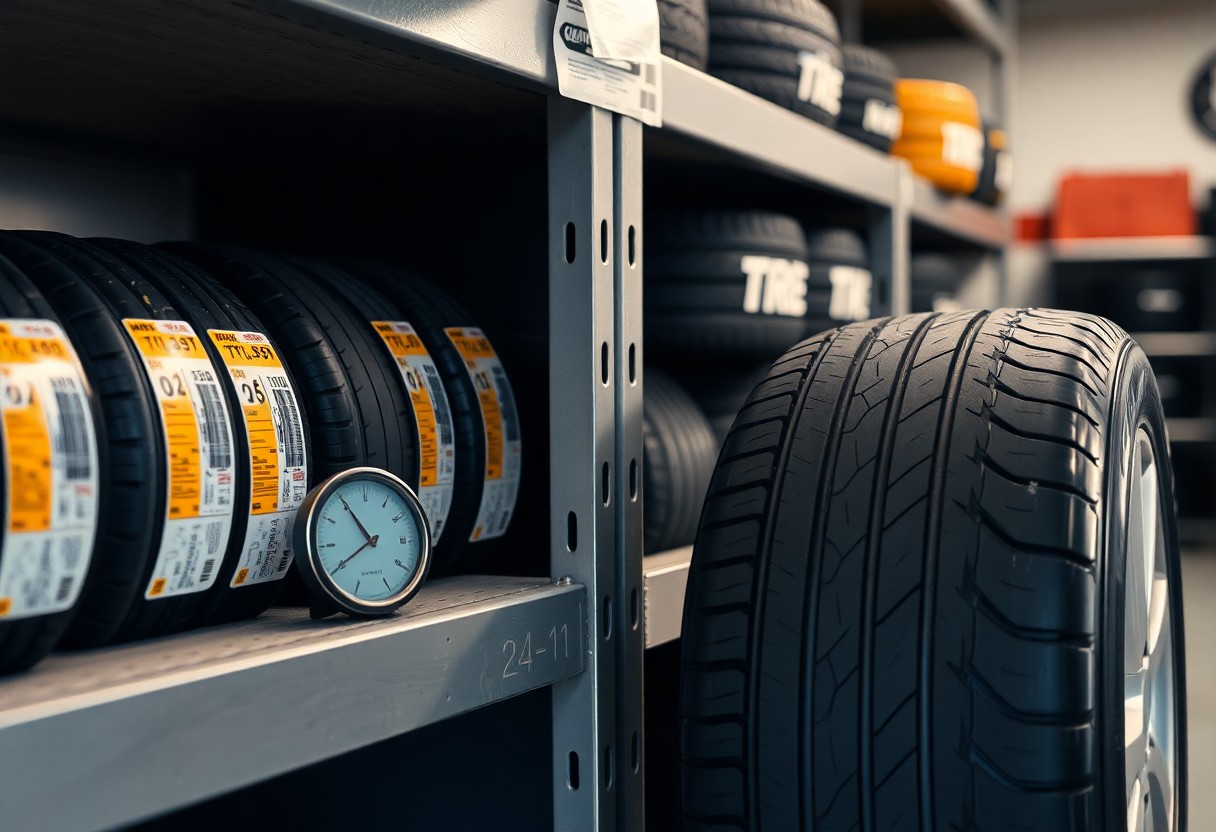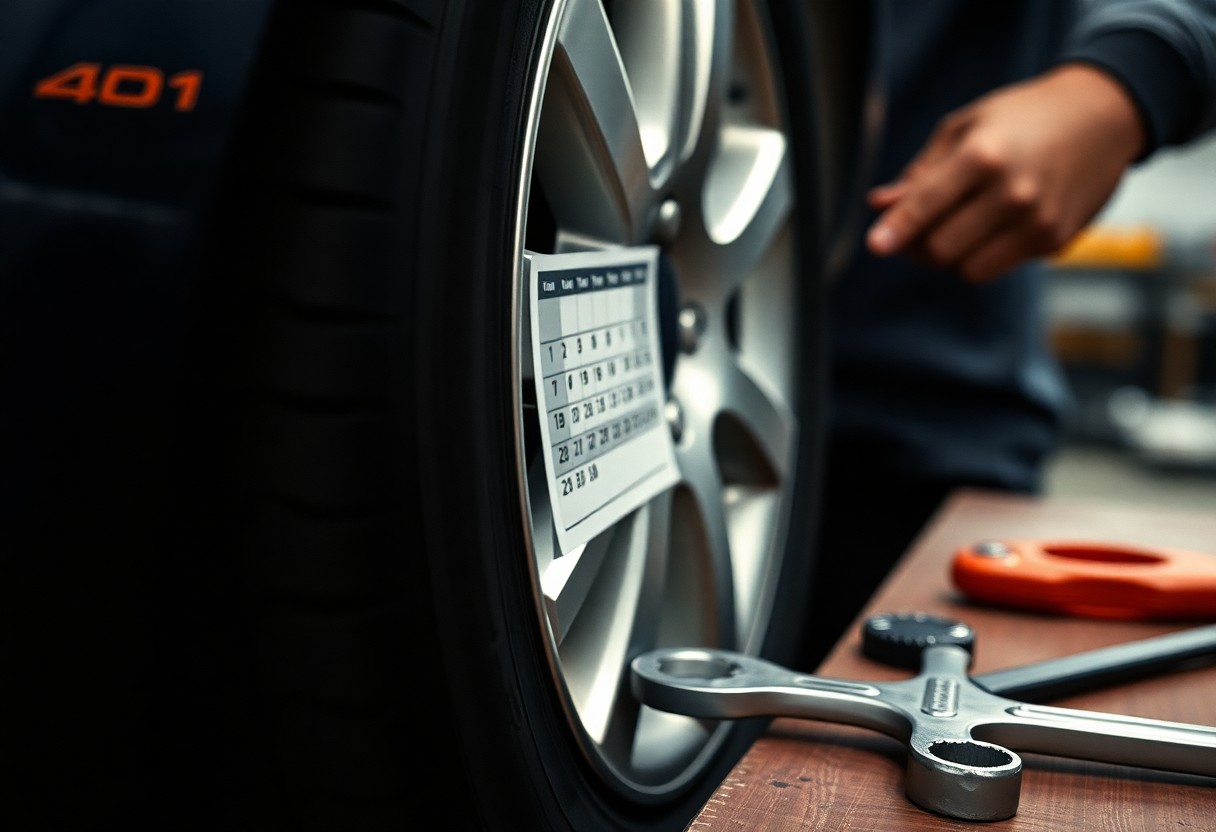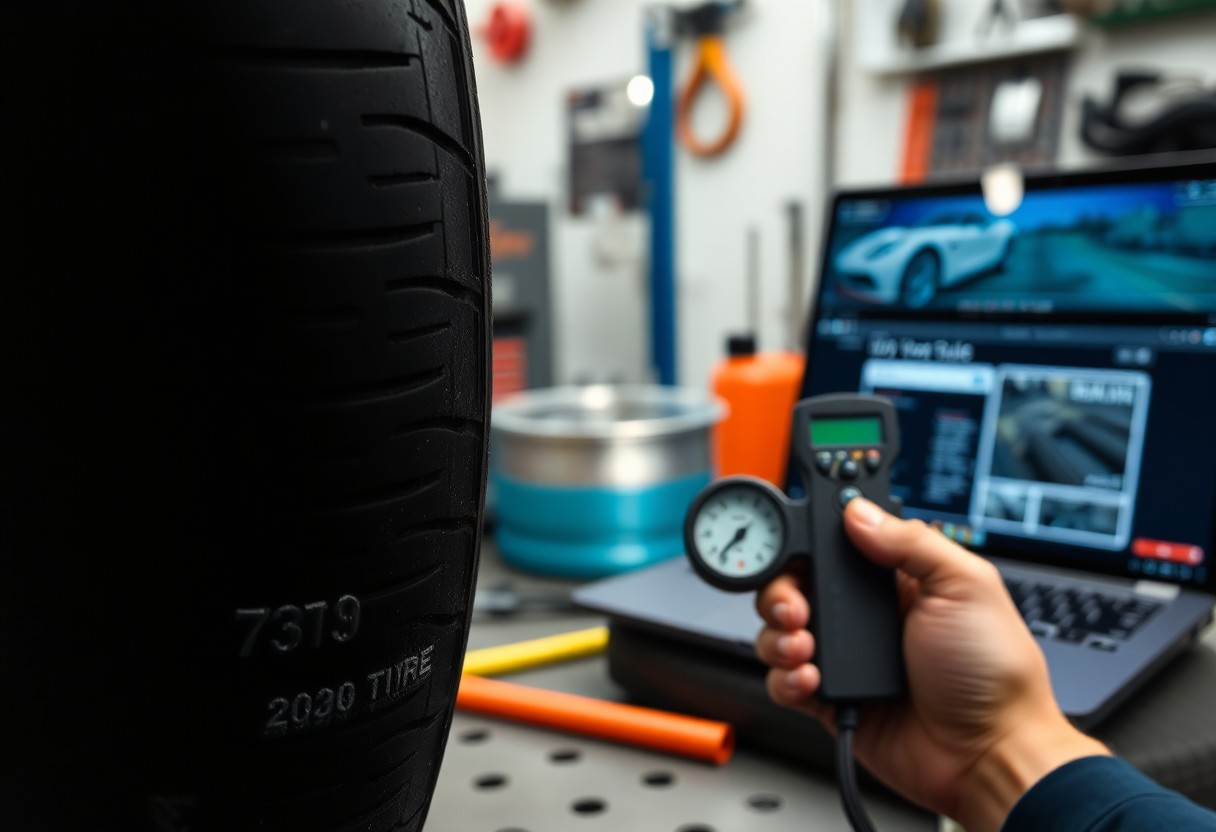Decoding Tyre Expiry Labeling
To find the expiry date of your tyres, locate the DOT code on the sidewall, typically shown as a series of numbers and letters. The last four digits of this code indicate the week and year of manufacture; for instance, a code of “2319” means the tyre was made in the 23rd week of 2019. Each tyre has a shelf life of about 6 to 10 years, even if the tread looks fine, so understanding this code is critical for your safety. If your tyres are older, consider replacing them to maintain optimal performance and safety on the road.
Key Takeaways:
- Check the sidewall of the tire for the DOT code to find the manufacturing date.
- The last four digits of the DOT code indicate the week and year of manufacture.
- Assess the age of the tires; they should typically be replaced every 6-10 years.
- Inspect tires for signs of wear, cracking, or damage to determine further usability.
- Consider environmental factors like exposure to sunlight and extreme temperatures affecting tire longevity.
- Maintain proper tire pressure and regular rotation to extend tire life.
- Consult a professional if unsure about the condition or age of the tires.

The Importance of Tyre Shelf Life
Every vehicle owner’s responsibility includes recognizing the shelf life of their tyres, which typically ranges from 6 to 10 years depending on the manufacturer. With environmental factors like temperature shifts, humidity, and exposure to sunlight, tyres degrade over time, even when they appear to have adequate tread. Ensuring that your tyres are not only in good condition but also within their usable lifespan can significantly enhance your driving experience and reduce risk on the road.
Safety Risks Associated with Expired Tyres
Expired tyres can present numerous safety hazards, including blowouts and diminished traction, leading to potentially fatal accidents. As rubber compounds age, they lose elasticity and structural integrity, which directly affects your vehicle’s handling. In wet or icy conditions, your expired tyres’ diminished grip can drastically increase stopping distances and reduce your overall control.
Legal and Insurance Considerations
Using expired tyres may lead to legal repercussions, including fines and penalties for non-compliance with vehicle safety regulations. Insurance companies might also deny claims if your vehicle involved in an accident was fitted with expired tyres, citing negligence on your part. Furthermore, you may face liability issues when accidents occur and it is found that your vehicle was not roadworthy due to improper tyre maintenance.
In some jurisdictions, driving on tyres beyond their recommended shelf life can open you up to significant financial repercussions. If involved in an accident, law enforcement may assess the condition of your tyres, which could affect ticketing or liability determinations. Insurers might claim that you failed to uphold your duty to maintain your vehicle safely, leading to denied claims and costly legal battles, which underscores the importance of regular checks and timely replacements for achieving both safety and compliance.

Step-by-Step Guide to Checking Tyre Expiry Date
| Step | Description |
| 1 | Locate the DOT code on your tyres. |
| 2 | Interpret the numbers within the code. |
| 3 | Understand additional markings and symbols. |
Locating the DOT Code on Tyres
The DOT code can be found on the outer side of your tyres. Look for a series of letters and numbers printed or embossed on the sidewall; the code usually begins with ‘DOT’ followed by a series of characters that indicate the manufacturer and production details. You might need to rotate your tyres to access all sides effectively, ensuring you check all available tyres for complete information.
Interpreting the Numbers within the Code
The last four digits of the DOT code reveal the week and year your tyres were manufactured. For instance, if the code ends with ‘2219’, it indicates that your tyre was produced in the 22nd week of 2019. Tyres typically have a shelf life of around six years from their manufacturing date, which is vital for your safety and vehicle performance.
Understanding the manufacturing date can significantly impact your vehicle’s safety. If your tyres are more than six years old, they may not perform optimally, increasing the risk of blowouts or reduced traction levels. Always replace tyres that have surpassed their expiry date, even if the tread appears suitable. Keeping an eye on the date can prevent possible accidents.
Understanding Additional Markings and Symbols
Besides the DOT code, you may notice other markings on the tyres that provide pertinent information. Look for symbols denoting the tyre’s load index or speed rating, which indicate the maximum load capacity and speed that the tyre can safely handle. Symbols like the ‘M+S’ mark denote all-season capabilities and can also indicate tread design.
Additional markings offer insights into other performance attributes but can sometimes be overlooked. For instance, understanding load indices can help you match tyre capabilities with your vehicle’s weight, while speed ratings provide guidance on how your tyres will perform at high speeds. Knowledge of these indicators helps you make informed decisions regarding tyre maintenance and replacements, ensuring your driving remains both safe and efficient.
Maintenance Tips for Prolonging Tyre Life
Efficient tyre maintenance is vital for extending the lifespan of your tyres. Here are some key tips to keep in mind:
- Maintain proper tyre pressure
- Rotate your tyres every 5,000 to 7,500 miles
- Inspect tread depth regularly
- Avoid overloading your vehicle
- Store tyres properly when not in use
Assume that by following these simple tips, you will enhance both safety and performance while getting the most out of your tyres.
Proper Inflation and Storage Techniques
Keeping your tyres properly inflated is vital for optimal performance and longevity. Over-inflated tyres can lead to uneven wear, while under-inflation increases rolling resistance and affects fuel efficiency. Regularly check the tyre pressure using a gauge, ensuring that it meets the vehicle manufacturer’s specifications. Additionally, store your tyres in a cool, dry place away from direct sunlight to prevent degradation.
Scheduling Regular Inspections and Rotations
To maximize the life of your tyres, scheduling regular inspections is key. It’s wise to have a professional assess your tyres at least once a year. During these inspections, mechanics can check for signs of wear, damage, or misalignment. Furthermore, rotating your tyres based on manufacturer recommendations helps distribute wear evenly. This not only improves handling and safety but can also extend the overall life of your tyres, saving you money and reducing the risk of an unexpected blowout.

Responsible Disposal and Replacement Options
Disposing of expired or damaged tyres responsibly not only protects the environment but also enhances safety on the roads. It’s best to avoid tossing them in landfills, which contributes to environmental pollution. Instead, consider utilizing local resources and programs dedicated to tyre recycling and replacement. This ensures a more sustainable solution while keeping our streets safe.
Local Recycling Programs in Klang
Klang offers several local recycling programs that focus on sustainable tyre disposal. Many automotive shops and waste management facilities partner with recycling initiatives, allowing you to drop off your used tyres for proper handling. These programs recycle tyres into useful products such as rubberized asphalt, playground surfaces, and more, greatly reducing their environmental impact.
Selecting the Right Replacement Tyres
Pertaining to choosing replacement tyres, consider factors such as your driving habits, the climate in Klang, and your vehicle’s specifications. The right tyre can significantly affect your vehicle’s performance, fuel efficiency, and safety on the road. Look for reputable brands that meet safety standards, and consult professionals who can guide you based on your unique needs and preferences.
Evaluate your typical driving conditions to make informed decisions. For instance, if you frequently drive on wet or slippery roads, opt for tyres with enhanced grip and water dispersion features. Additionally, consider the tread pattern and rubber composition that align with your regular driving activities. Always check for warranties and customer reviews to ensure longevity and reliability, enabling a smooth and safe driving experience.
Final Words
Summing up, checking your tyre expiry date is a straightforward process that can significantly enhance your driving safety. By locating the DOT code, understanding its meaning, and considering the overall condition of your tyres, you can make informed decisions about when to replace them. Regular checks not only ensure compliance with guidelines but also improve your vehicle’s performance. Stay proactive about your vehicle’s maintenance, and make tyre care an integral part of your driving routine for safer journeys ahead.
FAQ
Q: How can I find the expiry date of my tyres?
A: The expiry date of your tyres can typically be found on the sidewall of each tyre. Look for the DOT (Department of Transportation) code, which includes a four-digit number. The first two digits represent the week of manufacture, while the last two indicate the year. For instance, a code that reads “2318” means the tyre was manufactured in the 23rd week of 2018.
Q: Is there a specific lifespan for tyres?
A: While the lifespan can vary by brand and type, many manufacturers recommend that tyres be replaced every six to ten years. However, factors such as usage, road conditions, and maintenance can influence their longevity. It’s advisable to consult your tyre manufacturer’s guidelines for the most accurate information.
Q: How do I visually inspect my tyres for wear or damage?
A: You can inspect your tyres by looking for signs of uneven wear, cracks, bulges, or any foreign objects lodged in the tread. The tread depth can be checked using a tread depth gauge or the penny test. Insert a penny into the tread; if you can see all of Lincoln’s head, it’s time for a replacement.
Q: What should I do if my tyres are expired?
A: If your tyres are past their expiry date, it is advised to replace them immediately. Driving on expired tyres can lead to safety hazards, including blowouts or loss of traction. Visit a trusted tyre shop for proper disposal and to purchase new tyres.
Q: Are there any regulations regarding tyre expiry in Klang?
A: In Malaysia, there are regulations concerning the safety and maintenance of tyres. While there is no fixed law enforcing tyre expiry dates, it is mandated that all vehicles on the road should be fitted with safe and roadworthy tyres. Regular inspections and compliance with manufacturer recommendations are important.
Q: Can I still use tyres that have a DOT code older than 6 years?
A: While it may still be legally permissible to use tyres that are older than six years, many experts advise against it. The rubber compounds can degrade over time, which may not be visible externally. It’s recommended to assess their condition professionally and consider replacement if they are older than the recommended lifespan.
Q: Where can I get my tyres checked in Klang?
A: In Klang, a variety of automotive service centers and tyre shops offer tyre safety checks and replacements. Look for established providers with good reviews or ask for recommendations from friends or family. Many shops also provide complimentary inspections, ensuring your safety on the road.
